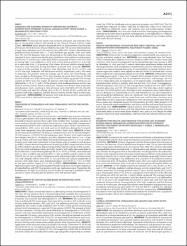Please use this identifier to cite or link to this item:
https://hdl.handle.net/20.500.11779/829| Title: | Assessing the Economic Burden of Rheumatoid Arthritis Patients With Different Clinical Disease Activity Index Scores: a Probabilistic Matching Study | Authors: | Kariburyo, F Du, J Xie, L Başer, Onur |
Source: | Kariburyo F, Du J, Xie L, Baser O. (May 21-25, 2016). Assessing the economic burden of rheumatoid arthritis patients with different clinical disease activity index scores: a probabilistic matching study. International Society for Pharmacoeconomics and Outcomes Research (ISPOR) 21st Annual International Meeting. Washington DC. | Abstract: | To evaluate the health care resource utilization and economic burdenof rheumatoid arthritis (RA) based on the Clinical Disease Activity Index(CDAI). Adult patients diagnosed with RA (International Classificationof Diseases, Ninth Revision, Clinical Modification code 714.xx) were identified froma large claims database and a RA registry from 2006-2015. Patients identified wereprobabilistically matched with a 1:1 ratio based on age, gender, state, and indexyear. The first RA diagnosis date was designated as the index date. Patients wererequired to have continuous health plan enrollment with medical and pharmacybenefits for 12 months post-index date (follow-up period). Patients were classifiedas having high (> 22), moderate (> 10 to ≤ 22), or low disease activity (> 2.8 to ≤ 10),or in remission (0 to ≤ 2.8) based on CDAI scores. All-cause and RA-related healthcare costs and utilization during the follow-up period were assessed. A total of 3,749 matched RA patients were identified, and 24.11%, 31.93%, and26.91% had high, moderate, and low disease activity, respectively, and 17.04% werein remission. RA patients were, on average, age 57 years, 76% were female, andmost resided in Washington (77%), with average all-cause total costs of $27,008and RA-related costs of $5,262 during the 12-month follow-up period. The averagenumber of office visits was higher for patients with high disease activity (12.31),followed by 11.79, 11.71, and 11.59 for patients with moderate disease activity, lowdisease activity, and for those in remission. Primary cost drivers were outpatientand pharmacy costs, resulting in total all-cause costs of $28,054, $27,285, $26,633,and $25,600, and total RA-related costs of $5,511, $5,280, $4,893, and $5,461 forpatients with high, moderate, and low disease activity, and for those in remission,respectively. RA patients with high disease activity, measured byCDAI score, have a substantial economic burden. | Description: | Onur Başer (MEF Author) ##nofulltext## |
URI: | https://hdl.handle.net/20.500.11779/829 |
| Appears in Collections: | Ekonomi Bölümü Koleksiyonu |
Files in This Item:
| File | Description | Size | Format | |
|---|---|---|---|---|
| Kariburyo-2016-Assessing-the-economic-burden-of-rh.pdf | Konferans Dosyası | 61.7 kB | Adobe PDF |  View/Open |
CORE Recommender
Page view(s)
38
checked on Jan 13, 2025
Download(s)
10
checked on Jan 13, 2025
Google ScholarTM
Check
Items in GCRIS Repository are protected by copyright, with all rights reserved, unless otherwise indicated.